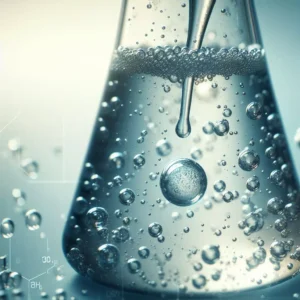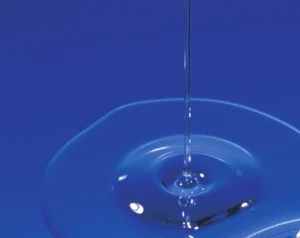How does phosphate esters work in defoaming industry?
How foam is formed
 Before we start, let’s take a look at how foam is formed. Foam occurs when gas and certain molecules called surfactants interact at the boundary between gas and liquid. Surfactant molecules have two distinct ends – one end attracts water (hydrophilic) while the other end repels water (hydrophobic).
Before we start, let’s take a look at how foam is formed. Foam occurs when gas and certain molecules called surfactants interact at the boundary between gas and liquid. Surfactant molecules have two distinct ends – one end attracts water (hydrophilic) while the other end repels water (hydrophobic).
When a liquid surface is present, the hydrophilic ends of surfactant molecules face outward towards the liquid, while the hydrophobic ends face inward. This arrangement forms a thin film that becomes the basis of foam formation.
Inside the foam, gas molecules get trapped within the surfactant film, creating pockets filled with gas. Once these pockets are filled with a sufficient amount of gas, foam starts to form.
Defoamers, on the other hand, work by breaking down the surfactant film, causing the foam structure to collapse and disappear. They essentially disrupt the stability of the foam by breaking the thin film that holds it together.
Common defoaming mechanisms
 Spreading action on the foam liquid film
Spreading action on the foam liquid film
Substances with defoaming properties are typically organic liquids that don’t mix well with foam but can quickly spread on its surface. These liquids have low surface tension and easily spread across the liquid film. As they spread, they can thin out the film in some areas, taking away a layer of liquid nearby. They also create disturbances on the surface, disrupting the film’s balance, which can cause it to break.
Insertion of defoamer molecules
Certain defoaming agents can penetrate the bubble film, replacing the original substances that stabilize the film and causing the foam to collapse.
Adsorption “replacement” of defoamer molecules on the foam liquid film
Some defoaming agents have strong adsorption properties. They dissolve in the foam solution and, because they are highly active, they quickly attach to the solution’s surface, displacing the original stabilizing molecules. However, these agents can’t form a stable film on their own. When defoamers that can’t form hydrogen bonds replace stabilizing agents capable of forming hydrogen bonds on the film surface, the film’s surface becomes less sticky. This leads to faster drainage and gas diffusion, reducing the foam’s lifespan and causing it to deflate.
Adding reaction agent
By adding chemical substances that react with the foaming agent (or stabilizing agents) to the foam liquid, it’s possible to neutralize or hinder the foaming agent’s ability to create bubbles. This disrupts the foaming process and prevents the foam from forming.
How does phosphate esters work
The defoaming mechanism of tributyl phosphate is similar to what the above has been described. The phosphate ions in the tributyl phosphate molecule can combine with hydroxyl groups, amino groups, and other active groups in the surfactant molecules, forming a hydrophobic film at the hydrophilic end of the surfactant molecules. This film can cover the surface of the foam. Due to the hydrophobic nature of tributyl phosphate molecules, they can disrupt the thin film formed by the surfactant molecules, causing the foam to rupture. This disruptive action can be achieved by disturbing the balance of the foam liquid film and reducing the surface tension of the film. Therefore, tributyl phosphate can act as a defoaming agent to eliminate foam formation and disrupt existing foam structures.
When a certain amount of tributyl phosphate is added to a foaming system, it can disperse uniformly and penetrate into the elastic film of the foam, forming a monomolecular film. It then diffuses to the gas-liquid interface, making it difficult for the surfactants responsible for stabilizing the foam to restore the elasticity of the film. This reduces foam adhesion and surface tension, leading to the rapid rupture of the foam film.
Tributyl phosphate is widely used as a defoaming agent due to its good penetration and dispersion properties. When added to industrial foams, it can quickly eliminate small bubbles and prevent re-foaming during subsequent industrial production, resulting in a prolonged defoaming effect. This is one of the reasons why this defoaming agent is extensively utilized.
Other typical defoaming agents
 Natural oils and their modified derivatives
Natural oils and their modified derivatives
1. Various animal and vegetable oils, such as cottonseed oil, castor oil, coconut oil, tung oil, and hop oil.
2. Animal fats like lard and tallow.
Animal and plant waxes like palm wax, beeswax, and whale wax.
Alcohols
1. Alcohols with branched structures, such as diethylene glycol, isooctanol, isobutanol, and diisobutyl methanol. Alcohols are temporary defoaming agents.
2. Synthetic fatty acids and fatty acid esters:
3. Insoluble fatty acids and their esters, many of which are non-toxic. Common examples include polyol fatty acid esters like ethylene glycol monostearate, glycerol monostearate, and sorbitan esters.
Amides
High molecular weight polyamides are used as defoaming agents in steam boiler water. Effective examples include dihardened tallow diamide, dibehenyl ethylene diamide, and acylated ethylenediamine condensates.
Phosphates
Tributyl phosphate is a commonly used defoaming agent. Other phosphates, such as tris(2-ethylhexyl) phosphate, triisobutyl phosphate, and organic ammonium salts of pentyl and octyl phosphates, are also commonly used.
Organosilicon compounds
Organosilicon compounds, particularly silicone fluids such as polydimethylsiloxane, and polyhydrogensiloxane are used as defoaming agents. Silicone resins also exhibit good defoaming and antifoaming properties.
Halogenated organic compounds
Halogenated hydrocarbons, especially fluorinated organic compounds like fluoro-chloroalkanes and perfluorocarbons, are commonly used as defoaming agents.
Polyether and polyether-type nonionic surfactants
Nonionic surfactants with short polyethylene glycol chains and block copolymers of polyethylene glycol and polypropylene glycol generally have poor foaming properties but excellent defoaming performance. They are commonly used as antifoaming agents.
Solid particle defoaming agents
Solid particle defoaming agents are characterized by their large surface area and hydrophobicity. Typical examples include silica dioxide, bentonite, diatomaceous earth, fatty amides, and heavy metal soaps.
Partnering up with a global leading material manufacturer that supplies diversified phosphate esters chemicals.
